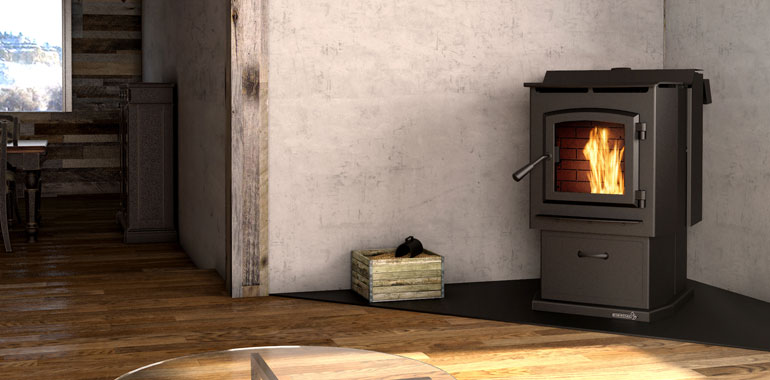
Pellet stoves have been around for over 4 decades. Their popularity stems from the ability to use waste and recycled wood. And with improved technologies and increased reliability, it’s easy to see why they are more popular than ever.
How Pellet Stoves Work
A hopper or bin, built-in the stove itself, stores the pellets. A motor then drives an auger that delivers the pellets to a burn pot or platform. The ‘feed rate’ is the speed at which the pellets are delivered to the burn chamber. The faster the ‘feed rate’, the more heat is produced. Conversely, the slower the feed rate, the less heat produced and the longer a bin full of pellets will last.
Unlike a wood stove, pellet stoves are dependent on electricity to operate. This is a consideration if you are in an area prone to power outage.
A small electric fan blows air through heat exchange tubes in the stove, picks up the heat from this hot steel and moves it into the room. Another fan forces the by-products from combustion out of the stove and through the vent pipe.
HOW THE PROCESS WORKS
Pellets are manufactured from wood waste such as wood chips, saw dust and scraps. This waste is then pulverized, put under extreme pressure, and heated to reduce the moisture content. Fibers are then fed through a pellet mill that forces this material through a small metal die, about the diameter of a pencil. Natural resins in the wood act as a glue to bind these particles together. They are then cut into ¾’ — 1” pieces.
Heat Output
It’s easy to control or adjust the amount of heat [LINK to: Why Heat With Pellets] from a pellet appliance. As any other heating appliances, heat output is dependent on how fast you burn fuel. As mentioned above, the feed rate dictates how much heat your appliance will produce and how long a full load of pellets will last. Heat output on most stoves typically range between 10,000 – 50,000 BTUs/hour.
Installation
Pellet stoves can be installed and vented through an outside wall. They can also be vertically vented through the roof. No chimney is necessary. Pellet stoves use a stainless steel “L vent” pipe.
Pellet stoves can also be vented into an existing chimney, using a four-inch stainless-steel liner. This is done periodically, when house owner wants to replace an old wood burning stove with a pellet model.
Convenience
Controls on a pellets stove ensure ease of use. Easy to read displays lets you adjust the feed rate, fan speed and other features. Wired or remote thermostat are also availability for even more flexibility.
If you don’t have quick and easy access to a wood supply or don’t have the time and/or equipment to cut, split, haul and stack wood, pellet stoves are a terrific alternative.
One useful feature to consider is a unit with a large hopper. By holding more pellets, you’ll get the benefit of longer burn times.
Much like bags of water softener salt, pellets come packaged in 40 lb (ca. 18 kg) bags. Average users consume about 2 – 3 tons of pellets per heating season. A winter’s supply will take up an area about 6’ wide x 6’ deep x 6’ high. That’s about 1/4th the space needed for an equivalent amount of cord word. Make sure you store pellets in dry corner of your garage, shed, utility room or basement. If you keep the leftover bags dry you can then use for the next heating season!
Environmental Factors
Consider these environmental reasons to burn wood pellets:
- Pellets are made from recycled and renewable biomass materials.
- Because of their low moisture content, pellets have greater energy and high combustion efficiency, as compared to cordwood.
- Pellets are carbon-neutral and have low emissions. Which means cleaner air.
Maintenance
If you’re the type of person that doesn’t like getting your hands dirty, do not buy a pellet stove. Many maintenance items are mandatory and must be done regularly. As wood pellets burn, the ash left behind is as fine as pepper. This ash will collect on the heat exchange tubes and the interior surfaces of the stove and significantly impede the heating efficiency of your appliance. Therefore, most of the required maintenance has to do with removing this fine ash. Until you get the cleaning routine down, this process can be a bit messy.
Your owner’s manual details the routine cleaning and maintenance procedures. As you follow it closely, your appliance will provide years of heating enjoyment for your home.
For information to any questions you may have, please contact your WE LOVE FIRE expert. We’d love to discuss the pro’s and con’s of pellet appliances with you.
Find a Local Store

